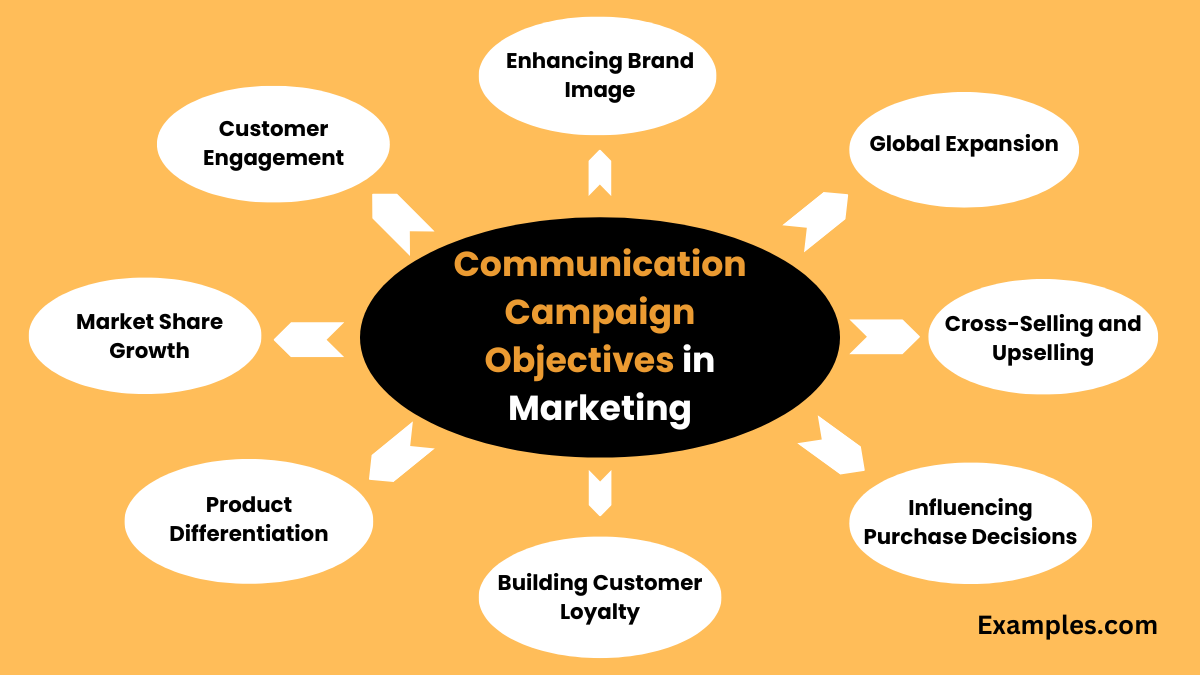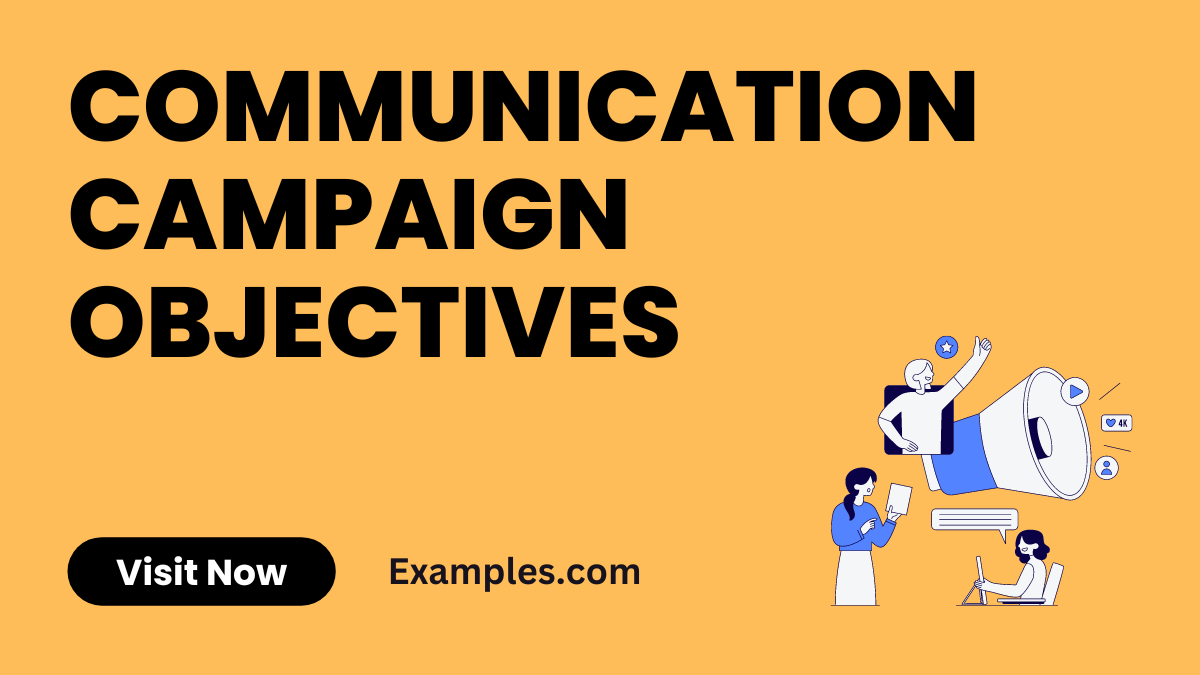19+ Communication Campaign Objectives Examples
Understanding the intricacies of Communication Campaign Objectives is vital for any successful marketing or public relations strategy. This comprehensive guide delves into the realm of communication objectives, offering practical examples to illustrate key concepts. It’s essential to recognize that these objectives are the backbone of any effective communication campaign, guiding the direction and measuring the success of your efforts. From raising brand awareness to driving consumer engagement, each objective is a stepping stone towards achieving your overall marketing goals. Incorporating Communication Objectives Examples within this guide not only enhances understanding but also provides real-world context, making it easier for professionals to apply these principles in their unique scenarios.
25 Communication Campaign Objectives

Communication campaign objectives are essential goals that a campaign aims to achieve, ranging from raising awareness to changing behavior. These objectives guide the strategic planning and execution of the campaign, ensuring that all messaging and activities align with the desired outcomes. Effective communication objectives are specific, measurable, achievable, relevant, and time-bound (SMART), tailored to the target audience and the overarching goals of the organization or brand.
- Increase Brand Awareness: Aim to enhance the visibility and recognition of your brand among your target audience.
Example: Launch a social media campaign with the tagline “Discover the Difference with [Brand Name]”, accompanied by eye-catching visuals and engaging content. - Boost Product Knowledge: Educate your audience about your product’s features and benefits.
Example: Create an educational video series demonstrating the unique features and benefits of your product, shared across multiple online platforms. - Strengthen Brand Loyalty: Foster a deeper connection with your audience to build lasting loyalty.
Example: Implement a customer loyalty program, promoted through email campaigns and social media, offering exclusive rewards and insider information. - Generate Leads: Use your campaign to attract potential customers and collect their contact information.
Example: Host a webinar on a relevant topic and offer free registration in exchange for contact details. - Increase Sales: Directly aim to boost product or service sales through your campaign.
Example: Offer a limited-time discount code in your marketing emails to encourage immediate purchases. - Enhance Customer Engagement: Encourage active participation and interaction from your audience.
Example: Create a hashtag challenge on social media where participants can share their experiences with your product. - Improve Public Relations: Build and maintain a positive public image for your organization.
Example: Organize a charity event and invite media coverage to showcase your company’s commitment to social responsibility. - Drive Website Traffic: Use the campaign to increase visits to your company’s website.
Example: Publish compelling blog content related to your industry, with links back to your website, shared across various online platforms. - Enhance Online Presence: Strengthen your brand’s visibility and engagement on digital platforms.
Example: Consistently post engaging content on your social media profiles and interact with your followers. - Promote New Products or Services: Introduce new offerings to the market through your campaign.
Example: Create a teaser campaign on social media leading up to the launch of a new product, building anticipation. - Educate Your Audience: Share valuable and relevant information with your audience to inform and enlighten them.
Example: Develop an infographic series that educates your audience about industry trends or how your product solves specific problems. - Create a Community: Build a community around your brand for long-term engagement and loyalty.
Example: Establish a brand-centric online forum or group where customers can discuss their experiences and share tips. - Support Customer Retention: Keep your current customers satisfied and engaged with your brand.
Example: Send regular newsletters with exclusive content and offers to your existing customer base. - Position as Industry Leader: Establish your brand as a thought leader in your industry.
Example: Publish whitepapers and research studies that showcase your expertise and insights in your field. - Attract Media Attention: Gain coverage from media outlets to broaden your campaign’s reach.
Example: Issue a press release about a groundbreaking new product or innovation from your company. - Facilitate Community Involvement: Get your audience involved in community or social causes.
Example: Launch a campaign where a portion of every sale is donated to a local charity, encouraging customer participation. - Foster Partnerships: Use the campaign to build relationships with other businesses or influencers.
Example: Collaborate with industry influencers for a joint social media campaign, combining audiences for greater impact. - Support Crisis Management: Communicate effectively during a crisis to manage public perception and maintain trust.
Example: In a crisis, issue transparent and regular updates to the public and stakeholders, addressing concerns and outlining responsive actions. - Encourage User-Generated Content: Motivate your audience to create and share their own content related to your brand.
Example: Start a photo contest where customers post pictures using your product, with a hashtag specific to your brand. - Promote Cultural Alignment: Align your brand with cultural events or movements that resonate with your audience.
Example: Launch a special edition product or campaign during significant cultural events or holidays that reflect your brand values. - Drive Event Attendance: Increase attendance and engagement for your company’s events.
Example: Create an event page on social media and engage with invitees through regular updates and teasers. - Boost Social Responsibility Image: Showcase your company’s commitment to social and environmental causes.
Example: Run a campaign highlighting your company’s sustainability initiatives and how customers can be part of the effort. - Improve Employee Engagement: Use internal communication campaigns to boost morale and involvement among staff.
Example: Initiate an internal campaign celebrating employee achievements and highlighting company milestones. - Enhance Market Research: Gather insights and data about your market and customers through your campaign.
Example: Conduct a customer survey as part of your campaign, offering incentives for participation. - Support Change Management: Communicate effectively about organizational changes to ensure smooth transitions.
Example: Implement a comprehensive communication plan addressing all stakeholder concerns during significant organizational changes.
Each objective, accompanied by its example, demonstrates the diverse goals a communication campaign can achieve, contributing significantly to the overall success of a brand or organization.
What is Communication Campaign Objectives in Advertising?
Communication campaign objectives in advertising are specific goals that an advertising campaign aims to achieve. These objectives guide the development and implementation of the campaign, ensuring that it effectively communicates the desired message to the target audience. Here are 10 key points that define these objectives:
- Brand Awareness: Increase recognition and recall of the brand among the target audience.
Example: A campaign designed to introduce a new brand to the market. - Product Launch: Communicate the launch of a new product or service.
Example: An ad series highlighting the features of a new technology product. - Rebranding: Reinforce a brand’s new image or position in the market.
Example: A campaign focusing on a brand’s new eco-friendly initiatives. - Lead Generation: Encourage potential customers to express interest or make inquiries.
Example: Ads with calls-to-action encouraging sign-ups for a free trial. - Customer Education: Educate consumers about the product or service and its benefits.
Example: Informative ads explaining the use and advantages of a new app. - Market Expansion: Reach new markets or demographics.
Example: A campaign targeting a younger audience for a traditional product. - Competitive Differentiation: Highlight the unique selling points that set the brand apart from competitors.
Example: Ads emphasizing a product’s unique features not offered by competitors.
Communication Campaign Objectives in Marketing

In marketing, communication campaign objectives are goals that a marketing campaign strives to achieve to influence the target audience’s perception and behavior. Here are 10 objectives commonly seen in marketing:
- Enhancing Brand Image: Create or improve the perception of the brand among consumers.
Example: Campaigns showcasing a brand’s commitment to sustainability. - Customer Engagement: Increase interaction between the brand and its customers.
Example: Interactive social media campaigns encouraging user-generated content. - Market Share Growth: Expand the brand’s share in the marketplace.
Example: Aggressive marketing strategies targeting competitor’s customer base. - Product Differentiation: Establish a product as distinct and superior to others.
Example: Ads focusing on a unique ingredient or technology used in the product. - Building Customer Loyalty: Foster a strong, lasting relationship with customers.
Example: Loyalty program promotions that reward repeat purchases. - Influencing Purchase Decisions: Persuade consumers to choose the brand’s products.
Example: Demonstrative ads showing the effectiveness of a product. - Cross-Selling and Upselling: Encourage customers to purchase complementary or premium products.
Example: Email campaigns suggesting additional products based on past purchases.
Communication Campaign Objectives in the Workplace
In the workplace, communication campaign objectives focus on internal communication goals that aim to improve employee engagement, productivity, and overall organizational health. Here are 10 objectives relevant to workplace communication:
- Employee Engagement: Increase employee involvement and commitment to the organization.
Example: Internal campaigns promoting company values and culture. - Change Management: Effectively communicate organizational changes to employees.
Example: Communication strategies for introducing new company policies. - Team Collaboration: Enhance collaboration and teamwork among employees.
Example: Initiatives encouraging cross-departmental projects and discussions. - Knowledge Sharing: Facilitate the sharing of information and best practices.
Example: Internal newsletters or intranet posts highlighting successful projects. - Employee Recognition: Acknowledge and celebrate employee achievements.
Example: Campaigns showcasing employee successes in company meetings - Crisis Communication:Provide clear and consistent communication during crises to maintain trust and morale.
Example: Regular updates from management during a significant organizational change. - Feedback and Suggestions: Encourage employees to provide feedback and suggestions.
Example: An internal campaign promoting the use of a suggestion box or feedback tool.
Communication campaign objectives, whether in advertising, marketing, or the workplace, serve as pivotal guides to design and implement effective strategies. These objectives not only help in achieving specific goals but also align efforts with the overall vision of the organization. Understanding and clearly defining these objectives is a fundamental step in creating successful campaigns that resonate with the intended audience, be it customers or employees, and deliver tangible results.



